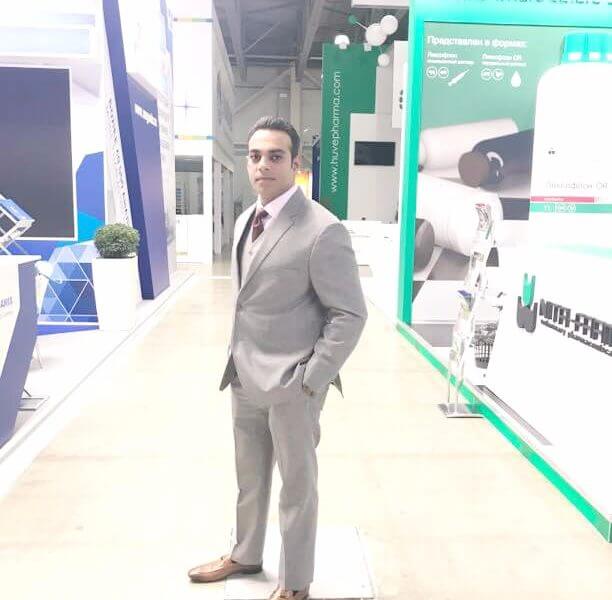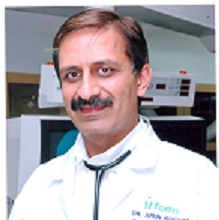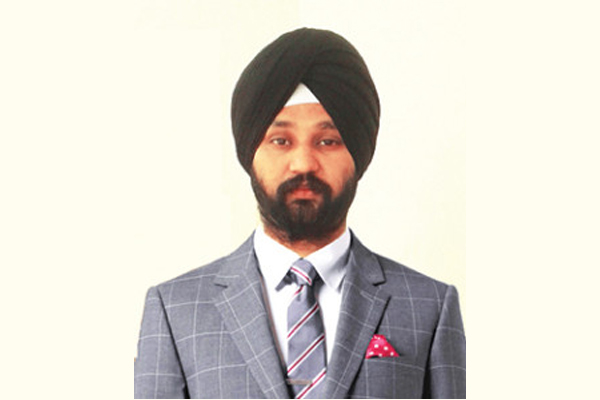
Photometry is the science of measurement of concentration of any analyte of interest by using its interaction with light at a particular wavelength, in this article Staff Engineer Kamaldeep Bansal and Technical Leader Saurabh Sona of the AMG Central Lab, STMicroelectronics Pvt Ltd, describe a state-of-the-art battery powered energy efficient portable system which is capable of measuring heart rate, hemoglobin and blood oxygen levels.

Kamaldeep Bansal, Staff Engineer, AMG Central Lab, STMicroelectronics Pvt Ltd
Photometry is very versatile and scalable and its underlying principle can be found at work even in high end lab spectrophotometres to portable consumer equipments. Beer-Lamberts law is the most commonly used principle for photometric applications.

BEER-LAMBERTS LAW: According to it, concentration of any analyte is directly proportional to the absorbance at its characteristic wavelength.
Absorbance is given by the following formula:
Abs=log_10â¡ã€–To/Ts〗
Where T0 is the transmittance/reflectance of light at zero concentration and TS is the transmittance/reflectance of light at the concentration to be measured.

In simple words, we can calculate its concentration by measuring the light intensity passing through any medium when the analyte of interest is absent (blank reading or T0) and then measuring the reduced light intensity in the presence of the analyte. Now, by just changing the wavelength at which this measurement is made and by changing the analyte and the chemical reaction involved, we can use the same basic principle for a variety of different measurements ranging from chemical analysis, environmental analysis and even medical analysis as in our case.

Saurabh Sona, Technical Leader, AMG Central Lab, STMicroelectronics Pvt Ltd
PHOTOMETERY IN MEDICAL APPLICATIONS:
Several popular consumer medical instruments use photometric methods to test parameters like blood glucose, heart rate, hemoglobin concentration etc. In most cases these are non-invasive in nature and can be easily adapted for minimal professional intervention during usage making them ideally suitable for consumer medical applications and POCT instruments.
TYPES OF PHOTOMETRIC ANALYSIS:
Following are the two types of photometric analysis most commonly used in medical applications:
- Diffused Reflectance Photometry
- Light Transmittance Photometry
Diffused ReflectancePhotometry:
Light of a particular wavelength is made incident on a specially formulated membrane on which the sample to be analyzed is collected. The intensity of diffused reflected light is captured using a photo detector. The output is processed to arrive at the actual value of the measurand. For hemoglobin, a 525 nm (Green) light source is most suitable for end results with accuracy of +/-0.5gm/dl. A suitable optical assembly with a collimating lens is used to aid proper illumination of the blood sample and to prevent interference from ambient light.
Light Transmittance Photometry:
Light is made to pass through the sample. Some of it gets absorbed and the rest passes through (transmitted). At the characteristic wavelength, the attenuation in this transmitted light intensity depends on the concentration of the analyte.
Heart rate monitor is based on the principle of Plethysmograph. Light is made to pass through the fingertip (can also be done at earlobes or toes). Some of it gets absorbed and the rest passes through (transmitted). The light gets attenuated by two factors. The static attenuation caused by the skin, flesh, bones and the pulsating attenuation dependent on the amount of blood present at any given moment due to the pumping action of the heart. Thus by detecting the frequency of this pulsating signal, we can accurately detect the heart rate. Usually the time taken for several pumping cycles is measured and used to calculate the BPM (Beats per Minute) value. In Heart rate monitor, light source of 880nm wavelength is commonly used.
Pulse Oximetery is the measurement of saturation of peripheral Oxygen saturation (SpO2). It actually shows the amount of oxygen that blood is carrying to the most peripheral parts of the body such as fingertips, earlobes or toes. It is measured as a percentage ranging from 0 to 100% where 100% reference is derived from the average group of healthy individuals.In case of Pulse Oximetry the variation in the ratio of light absorbed by oxygenated and de-oxygenated Hemoglobin at 660nm (red) and 910nm (IR) is used to estimate oxygen saturation (SpO2), in blood non-invasively. It is based on the fact that Oxygenated Hb present in arteries absorbs more of red light while de-Oxygenated Hb present in veins absorbs more IR light.
SYSTEM OVERVIEW:
The system is based on the ultra-low power STM32L series of MCUfrom STMicroelectronics.STM32L is based on the industry standard ARM Cortex M3 core and is especially designed for low power battery operated applications. The system can be powered from a 3V Lithium coin cell battery (CR2032) or from USB bus. An eight character alphanumeric LCD (Liquid Crystal Display) glass driven directly by the MCU (Microcontroller Unit) is used for its ability to display the required alphanumeric information while keeping the power consumption and system cost low. Multidirectional joystick is used for making the menu easily accessible.
Optical Sensing Assembly for Haemoglobin Metre: The sensor assembly integrates an aligned 525nm LED light source and photodiode detector with a slot to insert the testing strip used to collect the blood sample for Hb measurement. The optical assembly prevents external light from interfering with the measurements.
The system also has provisions to attach an 880nm IR-LED along with a photo transistor on either side of a finger using a clip arrangement. Timed samples of the photo transistor are used to calculate the heart rate.
Optical Sensing Assembly for Pulse Oximetre: Standard Nellcor compatible probe used for pulse oximetry, the 910nm(IR) and 660nm (red) LEDs are used to estimate oxygen saturation (SpO2). The two LEDs are connected in anti-parallel to save on the number of pins required to drive them. This requires a total of four transistors in a H-bridge configuration to generate the bi-directional signal required for driving the two LEDs.
Power Management Block:
System can be powered using an onboard 3V Lithium coin cell battery (CR2032). Optional power from USB can also be used to power the system using mini USB connector.
High Efficient Step Up Converter L6920 from STMicroelectronics converts the input voltage (down up to 1V) to+5V which serves as the input for the linear regulator “ STLQ50C33R (3.3V) and other peripherals operating at 5 volts. Low quiescent current (3μA) of STLQ50C33R enables it to achieve long stand by time even on the limited capacity of the CR2032 coin cell. Transistor 2STR2215 is usedto on/off 5V power going to the whole system for low power operation.
Analogue Front End: Opamp based signal conditioning circuit
The figure below shows the standard trans-impedance amplifier configuration typically used to convert the photodiode current into voltage. An important consideration for selection of photodiode interface opamp is that its input bias current should be less than the dark current of the photodiode used. The TSV612 opamp from STMicroelectronics has an input offset current typical value of 1pA. This makes it an excellent choice for this particular application. The output voltage VOis dependent on the value of the R connected between the output and the inverting input of the opamp.
Microcontroller:
Ultra low power high-performance ARM Cortex-M3 based controller STM32L152R8T6D is used in this application.It has in-built 12-bit ADC which facilitates direct interfacing of analog signal to the microcontroller. Integrated LCD Controller drives the LCD Glass to make the system portable and low cost.
Display:
In order to achieve low powerconsumption for high battery life, following display types wereshort listed for different applications:
LCD Glass:
Integrated LCD controller of microcontroller has a built-in LCD voltage generator that can drive up to 8 multiplexed LCDs with contrast independent of the supply voltage.
OLED
OLED based display was chosen for the Pulse Oximeter application as it has very low power consumption when compared to other backlit display technologies. This is because of the self-illuminating characteristics of the OLED where only the pixels to be lit are consuming power as compared to the static power consumption of the LED/CFL/CCFL based backlights.
Communication:
Microcontrollersembedded USB device peripheral is compatible with the USB full speed (12 Mbit/s). The dedicated 48 MHz clock is generated from the internal main PLL for minimum external component count.ESD Protection for High speed communication has been provided using ESDAULC6-3BP6 with Enhanced ESD protection (15 kV contact discharge & 15 kV air discharge)
LED Driving:
In a standard Nellcor compatible probe used for pulse oximetry, the IR and red LEDs are connected in anti-parallel to save on the number of pins required to connect the LEDs. When current flows in one direction, IR LED is on and when the current flows in the opposite direction, red LED turns on. This actually requires four switching elements to control the direction of the current flow. This arrangement is commonly known as an H-bridge as the four switching elements and the load across them resembles the letter H.
The additional consideration in this application is the requirement to control the magnitude of the current along with the direction to modulate the intensity of the light emitted by the LED. This is achieved by making the lower side of the H-bridge a voltage controlled current sink. The low side transistors are driven from two independent DAC outputs of the MCU and by varying the voltages at the base of these two transistors, we are able to control the currents flowing through the IR and the red LED which are turned on alternately.
Calculations and Calibration:
SpO2 measurements are based on the fact that oxygenated and de-oxygenated hemoglobin has different absorption for IR and red spectra at 910nm and 660nm respectively. Thus by measuring the ratio of this variation in intensity at the two wavelengths, we can derive the SpO2 levels non-invasively.
SpO2 is a value calculated by taking an average of many healthy individuals and taking it to be the 100% reference point. The rest of the values are calculated using an empirical relationship between the ratios of the IR and the red wavelength attenuation due to oxygenated and de-oxygenated hemoglobin.
Hemoglobinmeter is calibrated with the standard results for the precise measurement. Batch to batch variation in the sticks can be nullified by providing the different preconfigured batch information corresponding to the different batches.
Conclusion:
These techniques will be helpful in development of similar POCTs for other analytes in blood. The basic building blocks have been successfully demonstrated in practice and proven to consume very low power thus enhancing the number of measurements possible before requiring a battery replacement.
It has the potential to pave way for many other photometry and colorimetry based techniques like wet chemical photometry.
For countries like India, it is possible to equip the rural health workers (Anganwadi) with such portable and simple to use gadgets to provide first line of health check up. This applies to other developing nations as well where it is possible to run the applications on solar energy too!
Be a part of Elets Collaborative Initiatives. Join Us for Upcoming Events and explore business opportunities. Like us on Facebook , connect with us on LinkedIn and follow us on Twitter , Instagram.












